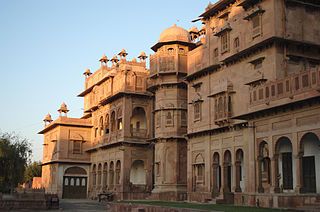Junagarh Fort
Junagarh Fort Road, Bikaner, Rajasthan 334001
Phone: 0151 220 2297
Junagarh Fort is a fort in the city of Bikaner. The fort was originally called Chintamani and was renamed Junagarh or “Old Fort” in the early 20th century when the ruling family moved to Lalgarh Palace outside the fort limits. It is one of the few major forts in Rajasthan which is not built on a hilltop. The modern city of Bikaner has developed around the fort.
The fort complex was built under the supervision of Karan Chand, the Prime Minister of Raja Rai Singh, the sixth ruler of Bikaner, who ruled from 1571 to 1611 AD. Construction of the walls and associated moat commenced in 1589 and was completed in 1594. It was built outside the original fort of the city, about 1.5 kilometres (0.93 mi) from the city centre. Some remnants of the old fort are preserved near the Lakshmi Narayan temple.
Historical records reveal that despite the repeated attacks by enemies to capture the fort, it was not taken, except for a lone one-day occupation by Kamran Mirza. Kamran was the second son of the Mughal Emperor Babur who attacked Bikaner in 1534, which was then ruled by Rao Jait Singh. In the battle, the Mughals were defeated by Rathors. Kamran then returned to Lahore.
The 5.28 hectares large fort precinct is studded with palaces, temples and pavilions. These buildings depict a composite culture, manifest in the mix of architectural styles.
Structures
Left: Views of palaces from the main courtyard built in Italian Carrara marble, Right: Karan Mahal and pond in the main courtyard, in Mughal style of architecture
The structures built within the Junagarh fort are the palaces and temples, which are made of red sandstone (Dulmera) and marble. The palaces are described as picturesque with their assortment of courtyards, balconies, kiosks and windows. The fort, the temples and the palaces are preserved as museums and provide insight into the grandiose living style of the past Maharanas of Rajasthan. The fort is called “a paradox between medieval military architecture and beautiful interior decoration”
Temples
Har Mandir temple was the royal chapel – private temple of the royal family. The royal family celebrated the Hindu festival of Dussera and Gangaur here, apart from celebrating other family functions such as birthdays and marriages. In the Dussera celebrations, weapons and horses were worshipped here. The main deities worshipped in this temple are the Hindu deities Lakshmi Narayan, a combined representation of god Vishnu and his consort Lakshmi.
The Ratan Behari temple located near the Junagarh Fort, was built in 1846 by the 18th ruler of Bikaner. It was built in Indo-Mughal architectural style using white marble. The Hindu god Krishna is deified in this temple.
Palaces
Karan mahal (Public Audience Hall) was built by Karan Singh in c.1680 to mark his victory over the Mughal Emperor Aurangzeb. It is considered as one of the most exquisite palaces built with gardens, which displays the aesthetic sensibilities of the royalty of Rajasthan. It has stained glass windows and intricately carved balconies built in stone and wood fluted columns. Later Rajas, Anup Singh and Surat Singh, also added lot of glitter to this palace with inlaid polychrome glass, intricate mirror patterns, and red and gold paint. In the coronation chamber, there is a shored up alcove, which was used as a throne.
Phool Mahal (“Flower Palace”) is the oldest part of the palace and was built by king Raja Rai Singh of Bikaner, who ruled between 1571-1668.
Anup Mahal is a multi-storey structure, which functioned as the administrative headquarters of the kingdom. It has ornate wooden ceilings with inlaid mirrors, Italian tiles, and fine lattice windows and balconies. It has some gold leaf paintings. It is considered as one of the “grandest construction”.
Chandra Mahal has the most luxurious room in the palace, which houses gold plated deities and paintings inlaid with precious stones. In the royal bedroom, mirrors have been strategically placed so that the Maharaja could see from his bed, any intruder entering his room.
Ganga Mahal was built in the 20th century by Ganga Singh who reigned for 56 years from 1887 to 1943, has a large durbar hall known as the Ganga Singh Hall that houses the Museum. The museum has exhibits of war weaponry and also a World War I aeroplane (biplane), which is stated to be well maintained.
Badal Mahal (The weather palace) is part of the Anup Mahal extensions. It has paintings of Shekhawati Dundlod chiefs paying respects to the Maharaja of Bikaner in different types of turbans. Photos of people standing on nails, wood, swords and saws are also depicted here – a display of faith and endurance. The walls in this palace depict fresco paintings of the Hindu god Krishna and his consort Radha amidst the rain clouds.
Bikaneri Havelies located both within and outside the fort in the Bikaner city’s by lanes are also of unique architectural style in home architecture. Aldous Huxley who visited these havelis reportedly said “They are the pride of Bikaner.”
Fort museum
The museum within the fort called the Junagarh Fort Museum was established in 1961 by Maharaja Dr.Karni Singhji under the control of “Maharaja Rai Singhji Trust”. The Museum exhibits Sanskrit and Persian manuscripts, miniature paintings, jewels, royal costumes, farmans (royal orders), portrait galleries, costumes, headgear and dresses of gods’ idols, enamelware, silver, palanquins, howdahs and war drums. The museum also displays armoury that consists of one of the assorted collection of post medieval arms.
Source : Wikipedia
https://www.youtube.com/watch?v=U3IWgDEOUIY
For More Images
Reviews
Visiting hours : 10.00AM to 04.30PM, all days of the week
Entry fee : Rs. 20/-for Indians and Rs.100/-for foreign tourists



Rate this article